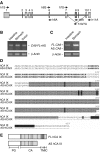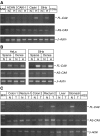Alternative splicing variant of the hypoxia marker carbonic anhydrase IX expressed independently of hypoxia and tumour phenotype
- PMID: 18026188
- PMCID: PMC2359689
- DOI: 10.1038/sj.bjc.6604111
Alternative splicing variant of the hypoxia marker carbonic anhydrase IX expressed independently of hypoxia and tumour phenotype
Abstract
CA IX is a hypoxia-induced, cancer-associated carbonic anhydrase isoform with functional involvement in pH control and cell adhesion. Here we describe an alternative splicing variant of the CA9 mRNA, which does not contain exons 8-9 and is expressed in tumour cells independently of hypoxia. It is also detectable in normal tissues in the absence of the full-length transcript and can therefore produce false-positive data in prognostic studies based on the detection of the hypoxia- and cancer-related CA9 expression. The splicing variant encodes a truncated CA IX protein lacking the C-terminal part of the catalytic domain. It shows diminished catalytic activity and is intracellular or secreted. When overexpressed, it reduces the capacity of the full-length CA IX protein to acidify extracellular pH of hypoxic cells and to bind carbonic anhydrase inhibitor. HeLa cells transfected with the splicing variant cDNA generate spheroids that do not form compact cores, suggesting that they fail to adapt to hypoxic stress. Our data indicate that the splicing variant can functionally interfere with the full-length CA IX. This might be relevant particularly under conditions of mild hypoxia, when the cells do not suffer from severe acidosis and do not need excessive pH control.
Figures




References
-
- Aasheim HC, Munthe E, Funderud S, Smeland EB, Beiske K, Logtenberg T (2000) A splice variant of human ephrin-A4 encodes a soluble molecule that is secreted by activated human B lymphocytes. Blood 95: 221–230 - PubMed
-
- Alvarez-Pérez J, Ballestros P, Cerdan S (2005) Microscopic images of intraspheroidal pH by 1H magnetic resonance chemical shift imaging of pH sensitive indicators. MAGMA 18: 293–301 - PubMed
-
- Anderson CJ, Hoare SF, Ashcroft M, Bilsland AE, Keith WN (2006) Hypoxic regulation of telomerase gene expression by transcriptional and post-transcriptional mechanism. Oncogene 25: 61–69 - PubMed
-
- Cecchi A, Hulikova A, Pastorek J, Pastorekova S, Scozzafava A, Winum JY, Montero JL, Supuran CT (2005) Carbonic anhydrase inhibitors. Design of fluorescent sulfonamides as probes of tumour-associated carbonic anhydrase IX that inhibit isozyme IX-mediated acidification of hypoxic tumours. J Med Chem 48: 4834–4841 - PubMed
Publication types
MeSH terms
Substances
LinkOut - more resources
Full Text Sources
Other Literature Sources

